The term terroir refers to the way a region's climate, soil and winemaking techniques converge to express themselves in your wine glass. Terroir-driven wines reflect a region's unique characteristics, meaning even wines made from the same grape variety can look, smell and taste very different depending on where they're from. While it's one thing to explore this concept by reading wine magazines, books or your favorite blog, it's another to have a world-renowned Sommelier and winemaker come to town and demonstrate it for you. Using his own wines.Such was the case recently, when one of the world's most celebrated Somms hosted a wine dinner for lucky wine lovers at one of our favorite local restaurants here in Delray Beach. The multi-course meal at 32 East featured two-time James Beard Award winner and author of Secrets of the Sommeliers, Rajat Parr, and wines from two of his latest vinous projects, Evening Land Vineyards and Domaine de la Côte, hailing from Oregon and California respectively.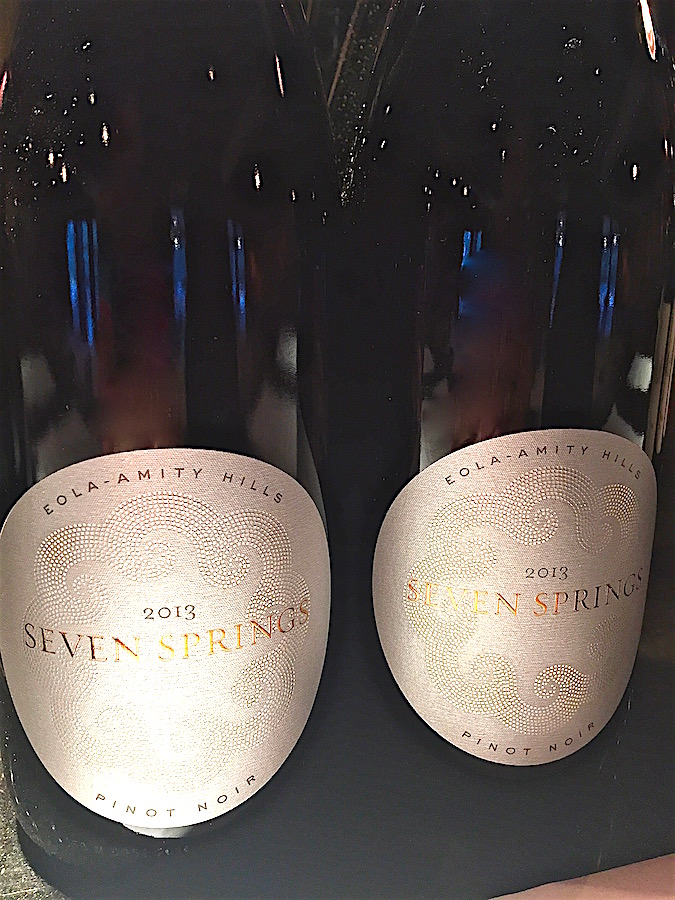 The sold out dinner featured a selection of Parr's Chardonnays and Pinot Noirs paired with the cuisine of 32 East Chef, John Thomas. During the course of the evening, Parr shared details of his own personal journey. Born and raised in Calcutta, Parr was first introduced to great wines at the age of 20 by his Uncle who lived in London. He later made his way to the United States and studied at the prestigious Culinary Institute of America's Hyde Park campus to become a Chef. After graduation, however, his love of the cellar prevailed and he proceeded to learn from the best. Parr honed his vinous acumen and tasting skills under the tutelage of Master Sommelier Larry Stone at his iconic San Francisco restaurant, Rubicon.Parr later joined forces with Chef Michael Mina as Wine Director of what would become The Mina Group's eponymous culinary empire, consisting of over 20 restaurants across the country. During this time, Parr's travels to European wine regions and work as a Somm gave rise to a curiosity about winemaking. He developed a particular affection for the wines of Burgundy and its hallmark grape varieties, Chardonnay and Pinot Noir. Santa Barbara winemaker Sashi Moorman shared Parr's love of balanced, food friendly wines and in 2011, the two partnered on their first of many winemaking ventures, Sandhi, which focused on Chardonnay and Pinot Noir from select vineyards in California's Sta. Rita Hills.
The sold out dinner featured a selection of Parr's Chardonnays and Pinot Noirs paired with the cuisine of 32 East Chef, John Thomas. During the course of the evening, Parr shared details of his own personal journey. Born and raised in Calcutta, Parr was first introduced to great wines at the age of 20 by his Uncle who lived in London. He later made his way to the United States and studied at the prestigious Culinary Institute of America's Hyde Park campus to become a Chef. After graduation, however, his love of the cellar prevailed and he proceeded to learn from the best. Parr honed his vinous acumen and tasting skills under the tutelage of Master Sommelier Larry Stone at his iconic San Francisco restaurant, Rubicon.Parr later joined forces with Chef Michael Mina as Wine Director of what would become The Mina Group's eponymous culinary empire, consisting of over 20 restaurants across the country. During this time, Parr's travels to European wine regions and work as a Somm gave rise to a curiosity about winemaking. He developed a particular affection for the wines of Burgundy and its hallmark grape varieties, Chardonnay and Pinot Noir. Santa Barbara winemaker Sashi Moorman shared Parr's love of balanced, food friendly wines and in 2011, the two partnered on their first of many winemaking ventures, Sandhi, which focused on Chardonnay and Pinot Noir from select vineyards in California's Sta. Rita Hills.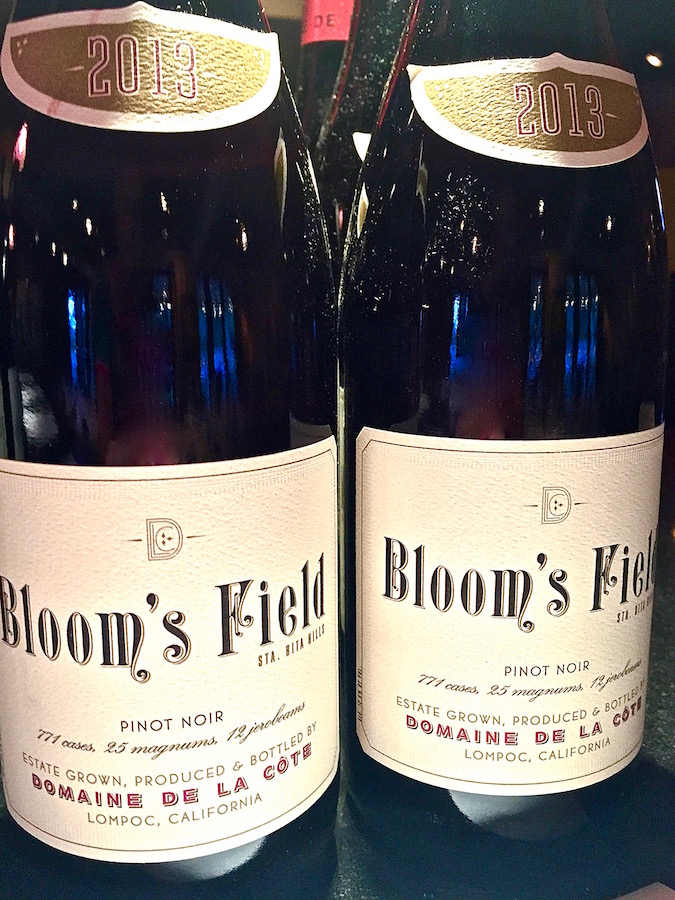 While the Sandhi wines were crafted from purchased grapes, in 2013 Parr debuted the wines of his new estate vineyard, Domaine de la Côte, located in California's western Sta. Rita Hills. In 2014, he and Moorman also took control of the acclaimed Seven Springs Vineyard in Oregon's Eola-Amity Hills. Riding on the momentum of these projects, and the desire to focus on making wine, Parr recently made two major life adjustments.In March he quietly (and amicably) parted ways with the Mina Group, sharing, "I'm officially retired from the restaurant, but they know they can call me any time." Parr is also winding down the trend-setting, controversial, non-profit wine group, In Pursuit of Balance he co-founded with Jasmine Hirsch in 2011. As set forth in their Manifesto of Balance, IPOB favors, "balanced, non-manipulated incarnations of Chardonnay and Pinot Noir." By eschewing the syrupy, high octane versions currently being marketed to US consumers, some acclaimed wine critics viewed the group as "elitist" which made some waves in the wine world. "We started it for fun and it was supposed to be a small intimate tasting but it became this big thing," he reflected. "It's just too much work now, but it definitely showed people the different styles of wine." The group's final tasting will take place in mid-November.
While the Sandhi wines were crafted from purchased grapes, in 2013 Parr debuted the wines of his new estate vineyard, Domaine de la Côte, located in California's western Sta. Rita Hills. In 2014, he and Moorman also took control of the acclaimed Seven Springs Vineyard in Oregon's Eola-Amity Hills. Riding on the momentum of these projects, and the desire to focus on making wine, Parr recently made two major life adjustments.In March he quietly (and amicably) parted ways with the Mina Group, sharing, "I'm officially retired from the restaurant, but they know they can call me any time." Parr is also winding down the trend-setting, controversial, non-profit wine group, In Pursuit of Balance he co-founded with Jasmine Hirsch in 2011. As set forth in their Manifesto of Balance, IPOB favors, "balanced, non-manipulated incarnations of Chardonnay and Pinot Noir." By eschewing the syrupy, high octane versions currently being marketed to US consumers, some acclaimed wine critics viewed the group as "elitist" which made some waves in the wine world. "We started it for fun and it was supposed to be a small intimate tasting but it became this big thing," he reflected. "It's just too much work now, but it definitely showed people the different styles of wine." The group's final tasting will take place in mid-November.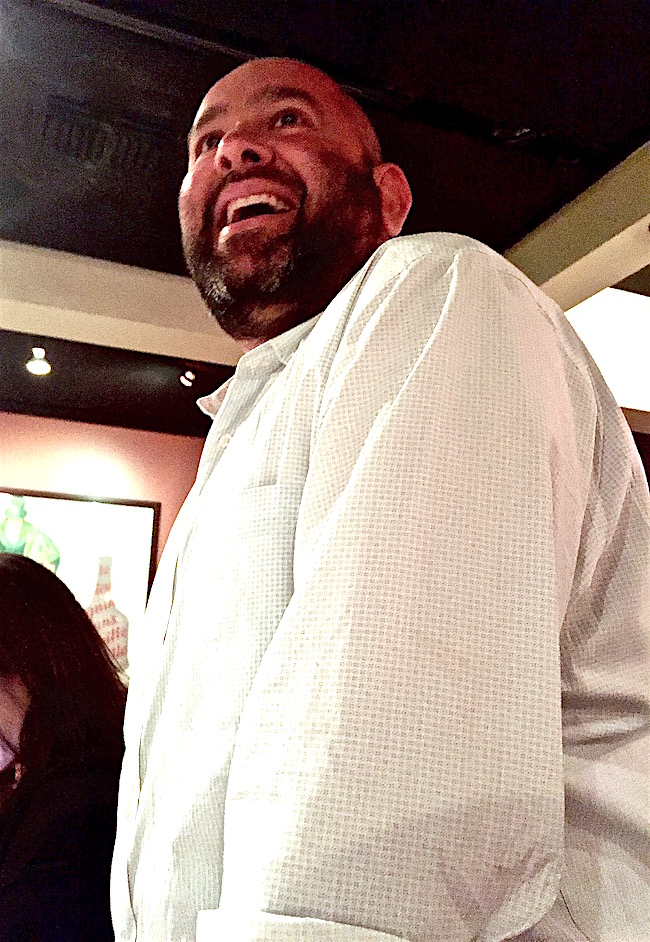 After being introduced by 32 East Manager John Bates, Parr began the evening by reiterating his preferred style of wine, "I prefer crisp, clean, fresh and energetic wines," while acknowledging, "I know the style in California is not necessarily that, but we make wine in a more European style...that's the path we follow."We started with Parr's Oregonian wines, specifically the enchanting 2012 Evening Land Vineyard Seven Springs Chardonnay which was lithe and crisp with a bright acidity. "2012 was an epic vintage in Oregon, but we made very little Chardonnay," Parr stated. "We took over while the 2012's were still in barrel, 2014 is the first vintage we had full control." Chef's Oak Roasted D'Anjou Pear with Whipped Goat Cheese, Spiced Pecans, Lemon Honey and Upland Cresse complemented the Chard beautifully, harmonizing with layers of citrus, stone fruit and pineapple accentuated by a kiss of toasty oak. The lovely white continued to evolve in the glass over the course of the next hour when I begrudgingly took my last sip.
After being introduced by 32 East Manager John Bates, Parr began the evening by reiterating his preferred style of wine, "I prefer crisp, clean, fresh and energetic wines," while acknowledging, "I know the style in California is not necessarily that, but we make wine in a more European style...that's the path we follow."We started with Parr's Oregonian wines, specifically the enchanting 2012 Evening Land Vineyard Seven Springs Chardonnay which was lithe and crisp with a bright acidity. "2012 was an epic vintage in Oregon, but we made very little Chardonnay," Parr stated. "We took over while the 2012's were still in barrel, 2014 is the first vintage we had full control." Chef's Oak Roasted D'Anjou Pear with Whipped Goat Cheese, Spiced Pecans, Lemon Honey and Upland Cresse complemented the Chard beautifully, harmonizing with layers of citrus, stone fruit and pineapple accentuated by a kiss of toasty oak. The lovely white continued to evolve in the glass over the course of the next hour when I begrudgingly took my last sip.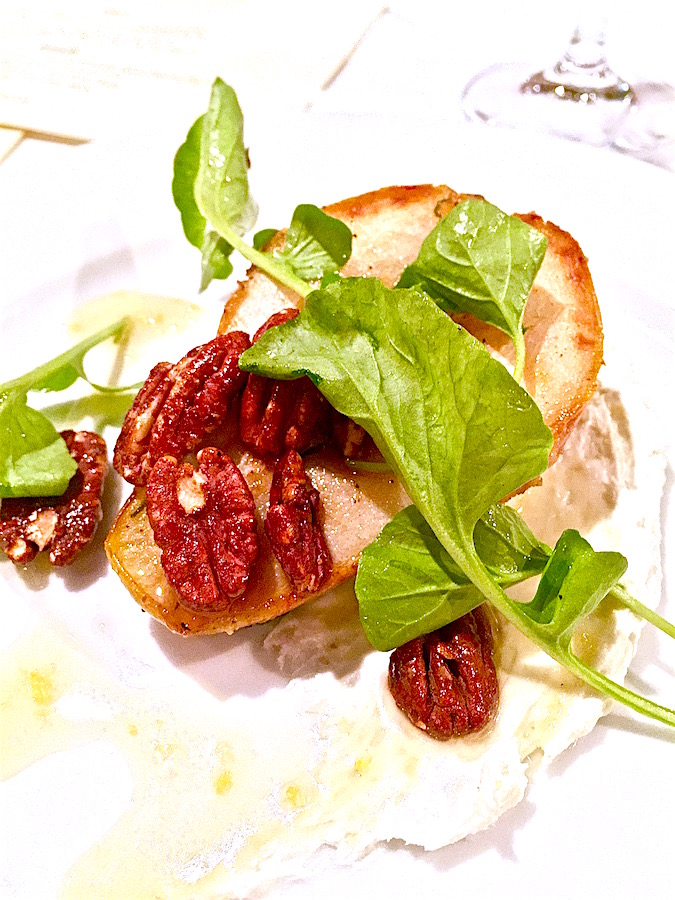 We continued with a duo of Evening Land Pinot Noirs from Oregon's Eola-Amity Hills which Parr described as, "A beautiful place with rolling hills that looks like the southern part of Burgundy." We began with the '13 Eola-Amity Hills Pinot paired with Coriander Spiced Yellowfin Tuna with Chickpea & Grilled Onion Salad, Tahini, Pomegranate and Basil. The wine was bright and lively with ebullient notes of ripe red cherry, pomegranate and spice. While it paired nicely with the spiced tuna, this wine's versatile acidity and medium body made it an equally good pairing with the bright fruit flavors of the next dish as well.The '13 Seven Springs Vineyard Pinot was paired with Roasted Long Island Duck Breast with Parmesan Polenta, Pinot Noir Reduction, Poached Plum and Local Greens. The single vineyard Pinot was more angular than the previous wine, exhibiting more minerality and tannin structure accompanied by similarly lovely notes of ripe red fruit, cherry and raspberry. It stood up nicely to the richness of the duck while synergizing with its delightfully fruity flavors.
We continued with a duo of Evening Land Pinot Noirs from Oregon's Eola-Amity Hills which Parr described as, "A beautiful place with rolling hills that looks like the southern part of Burgundy." We began with the '13 Eola-Amity Hills Pinot paired with Coriander Spiced Yellowfin Tuna with Chickpea & Grilled Onion Salad, Tahini, Pomegranate and Basil. The wine was bright and lively with ebullient notes of ripe red cherry, pomegranate and spice. While it paired nicely with the spiced tuna, this wine's versatile acidity and medium body made it an equally good pairing with the bright fruit flavors of the next dish as well.The '13 Seven Springs Vineyard Pinot was paired with Roasted Long Island Duck Breast with Parmesan Polenta, Pinot Noir Reduction, Poached Plum and Local Greens. The single vineyard Pinot was more angular than the previous wine, exhibiting more minerality and tannin structure accompanied by similarly lovely notes of ripe red fruit, cherry and raspberry. It stood up nicely to the richness of the duck while synergizing with its delightfully fruity flavors.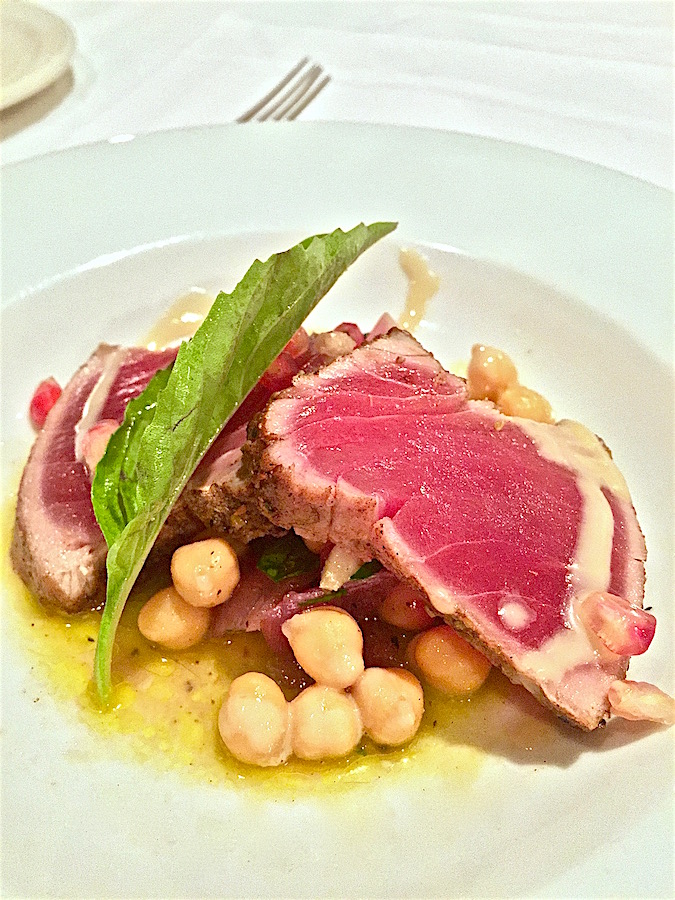
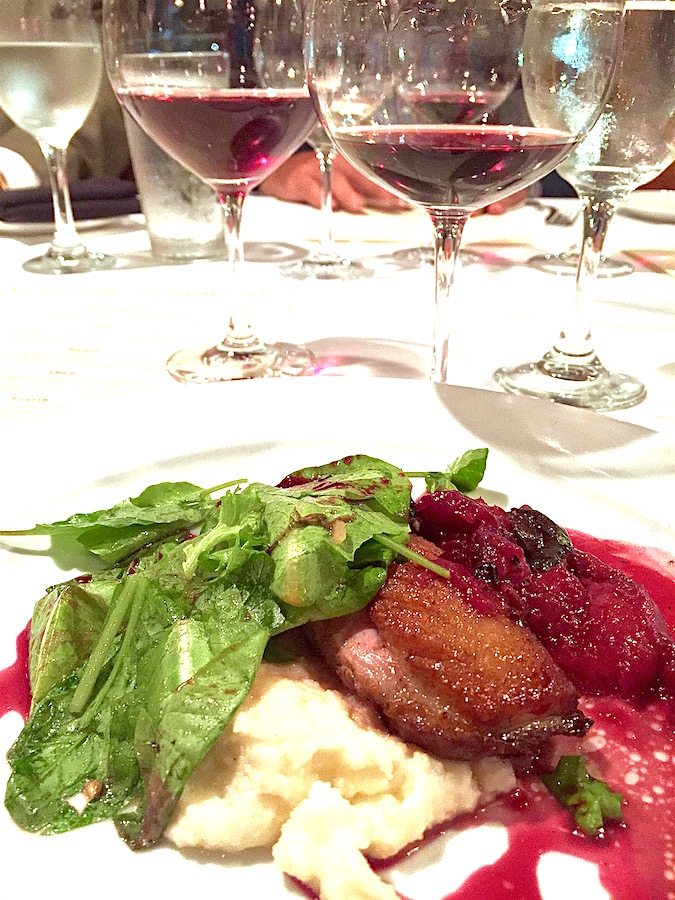 Next were the two Domaine de la Côte Pinots from California's Sta. Rita Hills. "The name means 'State of Slopes,'" Parr explained, "and we have five different vineyards planted on different soils in an amphitheater setting right on the coast of Santa Barbara, 8 miles from the ocean." When it comes to making wine, Parr stays true to his belief of minimal intervention in the vineyard and cellar, "We make the wines in a very traditional way, everything is fermented in whole clusters in large concrete tanks. The vines are all planted on virgin soils and grown organically with no additives."We enjoyed both Domaine de la Côte Pinots paired with Chef's Grilled Filet Mignon with Roasted Fingerling Potatoes, Wilted Greens and Wild Mushroom Jus. The '12 Sta. Rita Hills Pinot is a blend of different estate parcels, while the '13 Bloom's Field is a single vineyard offering. Parr explained, "2012 was a warmer vintage, while 2013 was cooler," which was readily evident when tasting the wines. The warmer temperatures of 2012 resulted in a wine with more perfumed aromatics of black cherry, cola and cassis and riper fruit, while the cooler 2013 vintage Bloom's Field single vineyard wine was more reserved with notes of spiced cherry, rose petal, earth and plum.
Next were the two Domaine de la Côte Pinots from California's Sta. Rita Hills. "The name means 'State of Slopes,'" Parr explained, "and we have five different vineyards planted on different soils in an amphitheater setting right on the coast of Santa Barbara, 8 miles from the ocean." When it comes to making wine, Parr stays true to his belief of minimal intervention in the vineyard and cellar, "We make the wines in a very traditional way, everything is fermented in whole clusters in large concrete tanks. The vines are all planted on virgin soils and grown organically with no additives."We enjoyed both Domaine de la Côte Pinots paired with Chef's Grilled Filet Mignon with Roasted Fingerling Potatoes, Wilted Greens and Wild Mushroom Jus. The '12 Sta. Rita Hills Pinot is a blend of different estate parcels, while the '13 Bloom's Field is a single vineyard offering. Parr explained, "2012 was a warmer vintage, while 2013 was cooler," which was readily evident when tasting the wines. The warmer temperatures of 2012 resulted in a wine with more perfumed aromatics of black cherry, cola and cassis and riper fruit, while the cooler 2013 vintage Bloom's Field single vineyard wine was more reserved with notes of spiced cherry, rose petal, earth and plum.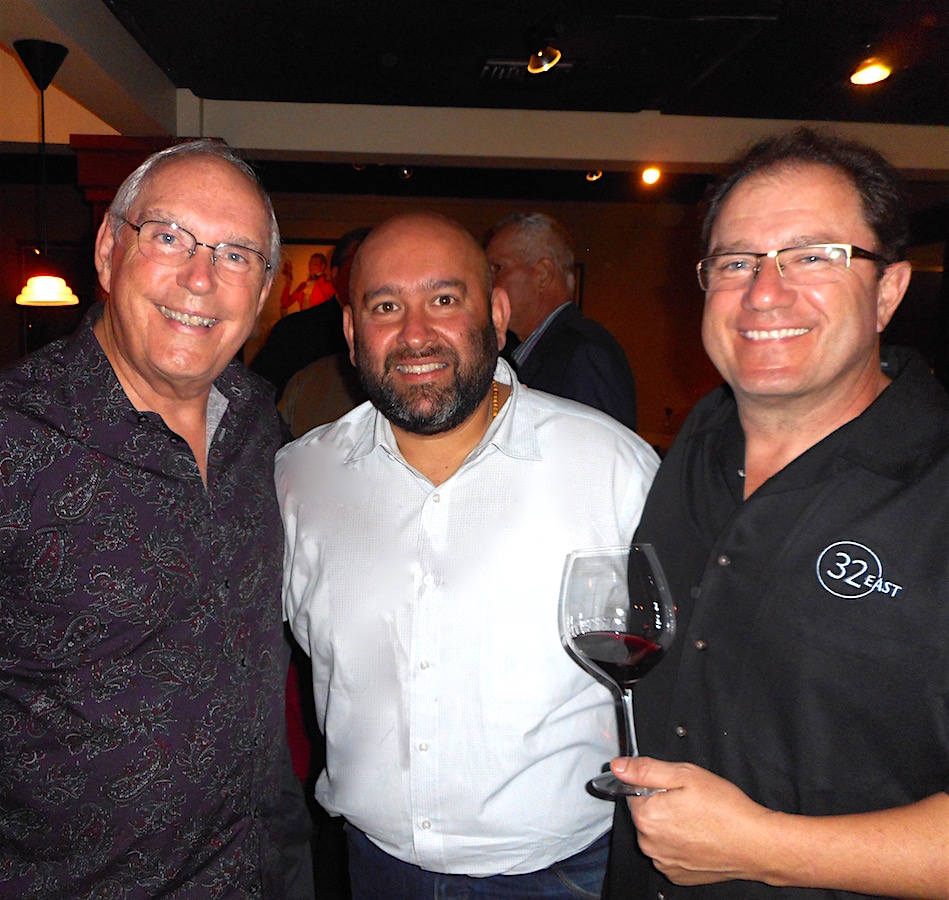 The opportunity to sample Parr's wines from Oregon and California side by side revealed differences between the two terroirs, 'The [Sta. Rita Hills] Pinots are lower in alcohol than the Oregon wines, yet they have more body, texture and aromatics. Oregon's volcanic soils result in more jagged tannins with smokier flavors while the marine sedimentary soil of California's Sta. Rita Hills results in wines that are velvety and fruity with notes of cola and Asian five spice that have lower tannins."When asked about aging these wines, he added, "The Sta. Rita Hills Pinots are probably best enjoyed when 5-7 years old, while Oregon Pinots are best 10-15 years old."
The opportunity to sample Parr's wines from Oregon and California side by side revealed differences between the two terroirs, 'The [Sta. Rita Hills] Pinots are lower in alcohol than the Oregon wines, yet they have more body, texture and aromatics. Oregon's volcanic soils result in more jagged tannins with smokier flavors while the marine sedimentary soil of California's Sta. Rita Hills results in wines that are velvety and fruity with notes of cola and Asian five spice that have lower tannins."When asked about aging these wines, he added, "The Sta. Rita Hills Pinots are probably best enjoyed when 5-7 years old, while Oregon Pinots are best 10-15 years old." Each wine we sampled during the course of the delightful evening, both the Chardonnay and Pinot Noirs, revealed its own distinct terroir reflecting its unique place of origin. Lucky dinner guests also got to enjoy a guided tour of these wines full of wonderful details and insights straight from the Somm's mouth.For more information on Raj Parr's wines, please visit the websites of Evening Land Vineyards and Domaine de la Côte.Bon appétit,
Each wine we sampled during the course of the delightful evening, both the Chardonnay and Pinot Noirs, revealed its own distinct terroir reflecting its unique place of origin. Lucky dinner guests also got to enjoy a guided tour of these wines full of wonderful details and insights straight from the Somm's mouth.For more information on Raj Parr's wines, please visit the websites of Evening Land Vineyards and Domaine de la Côte.Bon appétit,
The term terroir refers to the way a region’s climate, soil and winemaking techniques converge to express themselves in your wine glass. Terroir-driven wines reflect a region’s unique characteristics, meaning even wines made from the same grape variety can look, smell and taste very different depending on where they’re from. While it’s one thing to explore this concept by reading wine magazines, books or your favorite blog, it’s another to have a world-renowned Sommelier and winemaker come to town and demonstrate it for you. Using his own wines.
Such was the case recently, when one of the world’s most celebrated Somms hosted a wine dinner for lucky wine lovers at one of our favorite local restaurants here in Delray Beach. The multi-course meal at 32 East featured two-time James Beard Award winner and author of Secrets of the Sommeliers, Rajat Parr, and wines from two of his latest vinous projects, Evening Land Vineyards and Domaine de la Côte, hailing from Oregon and California respectively.

The sold out dinner featured a selection of Parr’s Chardonnays and Pinot Noirs paired with the cuisine of 32 East Chef, John Thomas. During the course of the evening, Parr shared details of his own personal journey. Born and raised in Calcutta, Parr was first introduced to great wines at the age of 20 by his Uncle who lived in London. He later made his way to the United States and studied at the prestigious Culinary Institute of America’s Hyde Park campus to become a Chef. After graduation, however, his love of the cellar prevailed and he proceeded to learn from the best. Parr honed his vinous acumen and tasting skills under the tutelage of Master Sommelier Larry Stone at his iconic San Francisco restaurant, Rubicon.
Parr later joined forces with Chef Michael Mina as Wine Director of what would become The Mina Group’s eponymous culinary empire, consisting of over 20 restaurants across the country. During this time, Parr’s travels to European wine regions and work as a Somm gave rise to a curiosity about winemaking. He developed a particular affection for the wines of Burgundy and its hallmark grape varieties, Chardonnay and Pinot Noir. Santa Barbara winemaker Sashi Moorman shared Parr’s love of balanced, food friendly wines and in 2011, the two partnered on their first of many winemaking ventures, Sandhi, which focused on Chardonnay and Pinot Noir from select vineyards in California’s Sta. Rita Hills.

While the Sandhi wines were crafted from purchased grapes, in 2013 Parr debuted the wines of his new estate vineyard, Domaine de la Côte, located in California’s western Sta. Rita Hills. In 2014, he and Moorman also took control of the acclaimed Seven Springs Vineyard in Oregon’s Eola-Amity Hills. Riding on the momentum of these projects, and the desire to focus on making wine, Parr recently made two major life adjustments.
In March he quietly (and amicably) parted ways with the Mina Group, sharing, “I’m officially retired from the restaurant, but they know they can call me any time.” Parr is also winding down the trend-setting, controversial, non-profit wine group, In Pursuit of Balance he co-founded with Jasmine Hirsch in 2011. As set forth in their Manifesto of Balance, IPOB favors, “balanced, non-manipulated incarnations of Chardonnay and Pinot Noir.” By eschewing the syrupy, high octane versions currently being marketed to US consumers, some acclaimed wine critics viewed the group as “elitist” which made some waves in the wine world. “We started it for fun and it was supposed to be a small intimate tasting but it became this big thing,” he reflected. “It’s just too much work now, but it definitely showed people the different styles of wine.” The group’s final tasting will take place in mid-November.

After being introduced by 32 East Manager John Bates, Parr began the evening by reiterating his preferred style of wine, “I prefer crisp, clean, fresh and energetic wines,” while acknowledging, “I know the style in California is not necessarily that, but we make wine in a more European style…that’s the path we follow.”
We started with Parr’s Oregonian wines, specifically the enchanting 2012 Evening Land Vineyard Seven Springs Chardonnay which was lithe and crisp with a bright acidity. “2012 was an epic vintage in Oregon, but we made very little Chardonnay,” Parr stated. “We took over while the 2012’s were still in barrel, 2014 is the first vintage we had full control.” Chef’s Oak Roasted D’Anjou Pear with Whipped Goat Cheese, Spiced Pecans, Lemon Honey and Upland Cresse complemented the Chard beautifully, harmonizing with layers of citrus, stone fruit and pineapple accentuated by a kiss of toasty oak. The lovely white continued to evolve in the glass over the course of the next hour when I begrudgingly took my last sip.

Oak Roasted D’Anjou Pear with Whipped Goat Cheese, Spiced Pecans & Lemon Honey
We continued with a duo of Evening Land Pinot Noirs from Oregon’s Eola-Amity Hills which Parr described as, “A beautiful place with rolling hills that looks like the southern part of Burgundy.” We began with the ’13 Eola-Amity Hills Pinot paired with Coriander Spiced Yellowfin Tuna with Chickpea & Grilled Onion Salad, Tahini, Pomegranate and Basil. The wine was bright and lively with ebullient notes of ripe red cherry, pomegranate and spice. While it paired nicely with the spiced tuna, this wine’s versatile acidity and medium body made it an equally good pairing with the bright fruit flavors of the next dish as well.
The ’13 Seven Springs Vineyard Pinot was paired with Roasted Long Island Duck Breast with Parmesan Polenta, Pinot Noir Reduction, Poached Plum and Local Greens. The single vineyard Pinot was more angular than the previous wine, exhibiting more minerality and tannin structure accompanied by similarly lovely notes of ripe red fruit, cherry and raspberry. It stood up nicely to the richness of the duck while synergizing with its delightfully fruity flavors.

Coriander Spiced Yellowfin Tuna with Chickpea & Grilled Onion Salad, Tahini, Pomegranate & Basil

Roasted Long Island Duck Breast with Parmesan Polenta, Pinot Noir Reduction & Poached Plum
Next were the two Domaine de la Côte Pinots from California’s Sta. Rita Hills. “The name means ‘State of Slopes,'” Parr explained, “and we have five different vineyards planted on different soils in an amphitheater setting right on the coast of Santa Barbara, 8 miles from the ocean.” When it comes to making wine, Parr stays true to his belief of minimal intervention in the vineyard and cellar, “We make the wines in a very traditional way, everything is fermented in whole clusters in large concrete tanks. The vines are all planted on virgin soils and grown organically with no additives.”
We enjoyed both Domaine de la Côte Pinots paired with Chef’s Grilled Filet Mignon with Roasted Fingerling Potatoes, Wilted Greens and Wild Mushroom Jus. The ’12 Sta. Rita Hills Pinot is a blend of different estate parcels, while the ’13 Bloom’s Field is a single vineyard offering. Parr explained, “2012 was a warmer vintage, while 2013 was cooler,” which was readily evident when tasting the wines. The warmer temperatures of 2012 resulted in a wine with more perfumed aromatics of black cherry, cola and cassis and riper fruit, while the cooler 2013 vintage Bloom’s Field single vineyard wine was more reserved with notes of spiced cherry, rose petal, earth and plum.

The opportunity to sample Parr’s wines from Oregon and California side by side revealed differences between the two terroirs, ‘The [Sta. Rita Hills] Pinots are lower in alcohol than the Oregon wines, yet they have more body, texture and aromatics. Oregon’s volcanic soils result in more jagged tannins with smokier flavors while the marine sedimentary soil of California’s Sta. Rita Hills results in wines that are velvety and fruity with notes of cola and Asian five spice that have lower tannins.”
When asked about aging these wines, he added, “The Sta. Rita Hills Pinots are probably best enjoyed when 5-7 years old, while Oregon Pinots are best 10-15 years old.”

Oregon (left) & California (right) Pinot Noirs even look different!
Each wine we sampled during the course of the delightful evening, both the Chardonnay and Pinot Noirs, revealed its own distinct terroir reflecting its unique place of origin. Lucky dinner guests also got to enjoy a guided tour of these wines full of wonderful details and insights straight from the Somm’s mouth.
For more information on Raj Parr’s wines, please visit the websites of Evening Land Vineyards and Domaine de la Côte.
Bon appétit,
![]()
The post A Special Evening with Sommelier Rajat Parr at 32 East appeared first on The Glamorous Gourmet.
Delray Beach, Florida has certainly come a loooooong way since I moved here 12 years ago. While some may say it's lost some of it's old school charm, I like to think we've made tremendous gains in the quality of our local cuisine! Unlike neighboring cities, Delray Beach has largely eschewed chain restaurants and given rise its own unique foodie culture instead. In order to spread the word about all this local deliciousness, I'll be happily highlighting my favorite Delray dishes here on the blog in our segment: Delray Foodie Faves. Our first installment brings us to Brulé Bistro and their positively mouthwatering and supremely comforting Potato Croquettes.Brulé Bistro is located in Delray's tony Pineapple Grove Arts District, and since it's incarnation in 2007, it has evolved from a gourmet market into a delightful American bistro and wine bar that is beloved by Delray locals. While I have enjoyed many delicious meals there over the years, there was just something about these potato croquettes! It was also by pure accident that I even tasted these delicious morsels and I hate to think how close I came to missing them - thanks, Matt!Hearty, flavorful and perfectly seasoned, the croquettes were served piping hot, topped with a dusting of bright green chives. The generous discs of mashed potatoes were lightly coated in bread crumbs, fried and then crowned with a delicious trinity of applewood smoked bacon, Cheddar cheese and a savory, smoky aïoli. I had already ordered a split of Heidsieck Monopole Brut Champagne and the two together were sheer perfection! Now this is definitely not a healthy dish, nor particularly flashy and definitely does not require any fancy foodie technology, but if you are in the mood for some edible comfort, I defy you to find a better dish! I'm no psychic, but with the Fall and Winter months upon us, I see many more potato croquettes in my immediate future.
If you live in Delray Beach, what are some of your favorite local dishes?
Where: Brulé Bistro, 200 NE 2nd Avenue, Delray Beach, FL 33444 orWebsite: www.brulebistro.comWhat: Potato Croquettes - they usually have them in one form or another on their menu but if you don't see them, ask your waiter!How much: approximately $7 for an order of 2Bon appétit,
Delray Beach, Florida has certainly come a loooooong way since I moved here 12 years ago. While some may say it’s lost some of it’s old school charm, I like to think we’ve made tremendous gains in the quality of our local cuisine! Unlike neighboring cities, Delray Beach has largely eschewed chain restaurants and given rise its own unique foodie culture instead. In order to spread the word about all this local deliciousness, I’ll be happily highlighting my favorite Delray dishes here on the blog in our segment: Delray Foodie Faves. Our first installment brings us to Brulé Bistro and their positively mouthwatering and supremely comforting Potato Croquettes.
Brulé Bistro is located in Delray’s tony Pineapple Grove Arts District, and since it’s incarnation in 2007, it has evolved from a gourmet market into a delightful American bistro and wine bar that is beloved by Delray locals. While I have enjoyed many delicious meals there over the years, there was just something about these potato croquettes! It was also by pure accident that I even tasted these delicious morsels and I hate to think how close I came to missing them – thanks, Matt!
Hearty, flavorful and perfectly seasoned, the croquettes were served piping hot, topped with a dusting of bright green chives. The generous discs of mashed potatoes were lightly coated in bread crumbs, fried and then crowned with a delicious trinity of applewood smoked bacon, Cheddar cheese and a savory, smoky aïoli. I had already ordered a split of Heidsieck Monopole Brut Champagne and the two together were sheer perfection! Now this is definitely not a healthy dish, nor particularly flashy and definitely does not require any fancy foodie technology, but if you are in the mood for some edible comfort, I defy you to find a better dish! I’m no psychic, but with the Fall and Winter months upon us, I see many more potato croquettes in my immediate future.
If you live in Delray Beach, what are some of your favorite local dishes?
Where: Brulé Bistro, 200 NE 2nd Avenue, Delray Beach, FL 33444 or
Website: www.brulebistro.com
What: Potato Croquettes – they usually have them in one form or another on their menu but if you don’t see them, ask your waiter!
How much: approximately $7 for an order of 2
Bon appétit,
![]()
The post Delray Foodie Faves: Brulé Bistro’s Potato Croquettes appeared first on The Glamorous Gourmet.
This time of year I love to revel in reds. Big, bold, complex, luxurious reds. And what better place to find them than California's Napa Valley? Recently, I had the pleasure of sampling one such red wine - our Wine of the Week, the 2012 Brandlin Vineyard Cabernet Sauvignon Mount Veeder.Who it's from: The Brandlin family were early pioneers of Mount Veeder and began farming grapes there in the early 1870's. The Brandlin Vineyard was founded in 1926 by Chester Brandlin's grandfather, and Chester himself continued to farm the vineyard for over 50 years. In an interview featured on the winery's website, Brandlin fondly recalls growing grapes during the tough Prohibition years which ultimately devastated California's budding wine industry. How did the family avoid getting caught? "We were good friends with the Sheriff," Brandlin remarked coyly.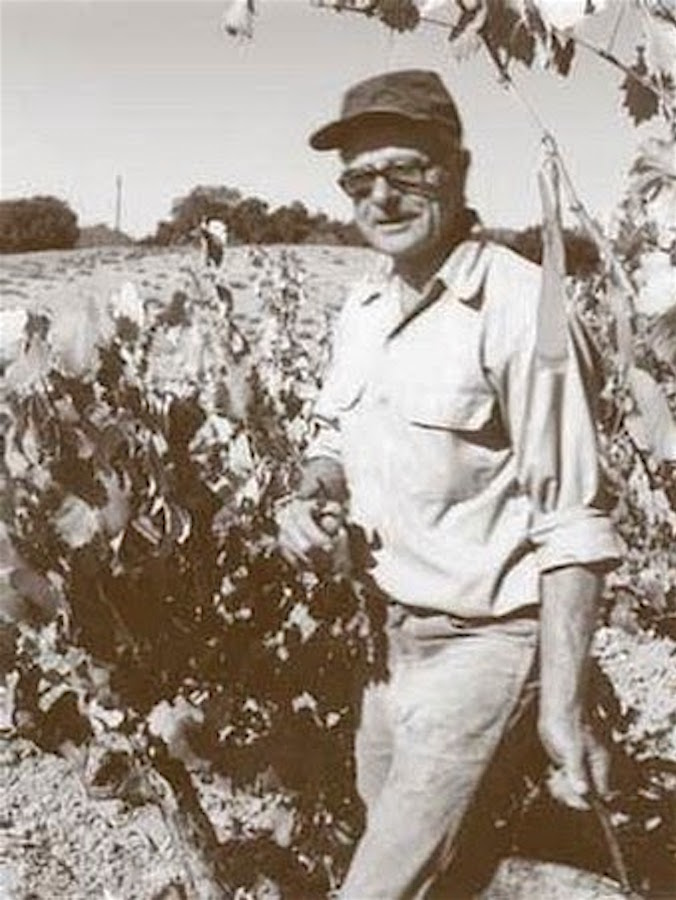 As winemaker for Napa Valley's Cuvaison and Brandlin since 2002, both of Cuvaison Estate Wines, Steven Rogstad honed his sense of terroir as a graduate student of Enology and Viticulture at UC Davis. During his studies, Rogstad experimented with non-commercial yeast strains on lots of wine from fifty different wineries across the appellation. This project also developed his ability to work with and blend small lots which is crucial to his winemaking style today. Over the years, Rogstad has worked with and advised such well-regarded names as Viader, Dominus, Duckhorn and Spottswoode. He was ultimately draw to Cuvaison's estate vineyard in Carneros as well as the opportunity to build their new winery from the ground up.
As winemaker for Napa Valley's Cuvaison and Brandlin since 2002, both of Cuvaison Estate Wines, Steven Rogstad honed his sense of terroir as a graduate student of Enology and Viticulture at UC Davis. During his studies, Rogstad experimented with non-commercial yeast strains on lots of wine from fifty different wineries across the appellation. This project also developed his ability to work with and blend small lots which is crucial to his winemaking style today. Over the years, Rogstad has worked with and advised such well-regarded names as Viader, Dominus, Duckhorn and Spottswoode. He was ultimately draw to Cuvaison's estate vineyard in Carneros as well as the opportunity to build their new winery from the ground up. Where it's from: Named for Dutch Pastor Peter Veeder in the mid-1800's, Mount Veeder is located among the southern Mayacamas mountains adjoining Carneros. Existing within the Napa AVA, the Mount Veeder AVA (American Viticultural Area) was established in 1993 and features vineyards which are highly exposed to elements including the winds off of San Pablo Bay. This exposure is responsible for Mount Veeder's unusually cool temperatures, resulting in the longest growing season of any AVA in Napa Valley.“Steep rocky soils and a moderate climate render intense, black fruited concentration and a powerful backbone of tannin that make this wine unique.” - Steven Rogstad, WinemakerThe Brandlin Vineyard is located on a Mount Veeder ridgeline on the valley’s west side. Perched at 900 to 1,150 feet in elevation, the vineyard is divided into 15 different blocks facing a multitude of different aspects. The varied differences in sun exposure, slope and soil composition provide distinct fruit characteristics in each block. These unique conditions have led to Mount Veeder's well-deserved reputation as an ideal place to grow world class Cabernet Sauvignon characterized by briary aromas and flavors with herbal and floral notes which are often powerful and high in tannin.
Where it's from: Named for Dutch Pastor Peter Veeder in the mid-1800's, Mount Veeder is located among the southern Mayacamas mountains adjoining Carneros. Existing within the Napa AVA, the Mount Veeder AVA (American Viticultural Area) was established in 1993 and features vineyards which are highly exposed to elements including the winds off of San Pablo Bay. This exposure is responsible for Mount Veeder's unusually cool temperatures, resulting in the longest growing season of any AVA in Napa Valley.“Steep rocky soils and a moderate climate render intense, black fruited concentration and a powerful backbone of tannin that make this wine unique.” - Steven Rogstad, WinemakerThe Brandlin Vineyard is located on a Mount Veeder ridgeline on the valley’s west side. Perched at 900 to 1,150 feet in elevation, the vineyard is divided into 15 different blocks facing a multitude of different aspects. The varied differences in sun exposure, slope and soil composition provide distinct fruit characteristics in each block. These unique conditions have led to Mount Veeder's well-deserved reputation as an ideal place to grow world class Cabernet Sauvignon characterized by briary aromas and flavors with herbal and floral notes which are often powerful and high in tannin.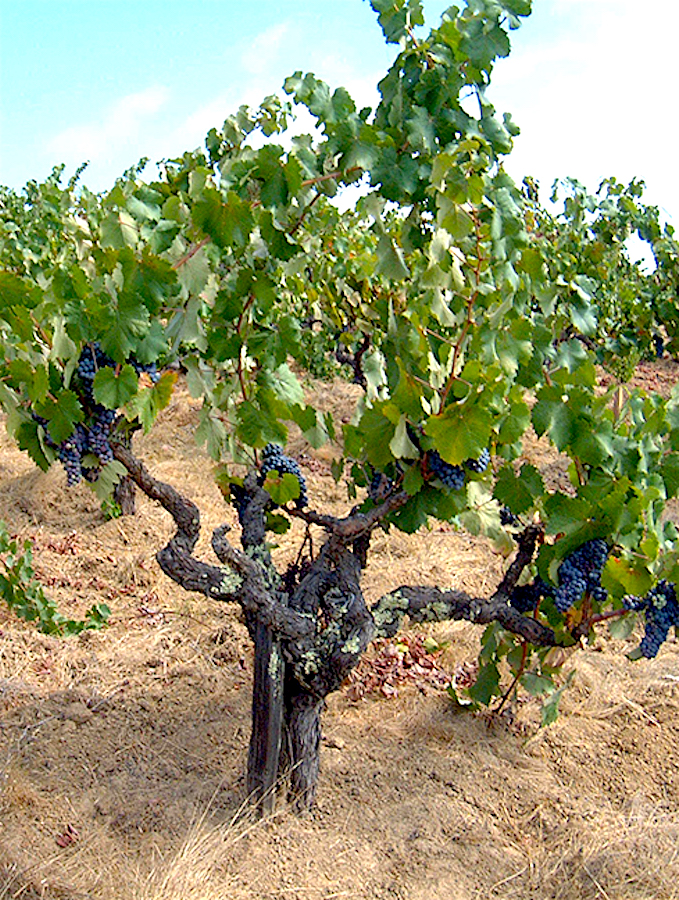 Wine by the (Geeky) Numbers:Harvest Date: Oct 11- 30Age of Vines: 12 years averageFermentation: 15 - 28 daysBarrel Aging: 22 months in small French oak barrels (50% new)ML: 100%Blend: 77% Cabernet Sauvignon, 9% Malbec, 9% Cabernet Franc and 5% Petit VerdotAlcohol: 14.5%Acid: 6.2pH: 3.70The Glamorous Gourmet's Tasting Note: The Brandlin Vineyard Cabernet Sauvignon Mount Veeder possesses an opaque, deep purple color and aromas of spiced red and black fruit. On the palate, this opulent wine demonstrates remarkable balance while exhibiting notes of ripe blackberry, cassis, earth and luxuriously firm tannins. The wine's harmonious flavors and textures hold together beautifully on the long, lingering finish.Pair it with: Enjoy this immensely pleasurable wine with a juicy, well-marbled New York Strip Steak, our own delicious Steak au Poivre or even an aged cheese. Roast duck or pork with a blackberry sauce would also be fabulous!MSRP: $68 (for purchasing information, please e-mail stephanie@theglamorousgourmet.com or call 561.317.6663)Bon appétit,
Wine by the (Geeky) Numbers:Harvest Date: Oct 11- 30Age of Vines: 12 years averageFermentation: 15 - 28 daysBarrel Aging: 22 months in small French oak barrels (50% new)ML: 100%Blend: 77% Cabernet Sauvignon, 9% Malbec, 9% Cabernet Franc and 5% Petit VerdotAlcohol: 14.5%Acid: 6.2pH: 3.70The Glamorous Gourmet's Tasting Note: The Brandlin Vineyard Cabernet Sauvignon Mount Veeder possesses an opaque, deep purple color and aromas of spiced red and black fruit. On the palate, this opulent wine demonstrates remarkable balance while exhibiting notes of ripe blackberry, cassis, earth and luxuriously firm tannins. The wine's harmonious flavors and textures hold together beautifully on the long, lingering finish.Pair it with: Enjoy this immensely pleasurable wine with a juicy, well-marbled New York Strip Steak, our own delicious Steak au Poivre or even an aged cheese. Roast duck or pork with a blackberry sauce would also be fabulous!MSRP: $68 (for purchasing information, please e-mail stephanie@theglamorousgourmet.com or call 561.317.6663)Bon appétit,
This time of year I love to revel in reds. Big, bold, complex, luxurious reds. And what better place to find them than California’s Napa Valley? Recently, I had the pleasure of sampling one such red wine – our Wine of the Week, the 2012 Brandlin Vineyard Cabernet Sauvignon Mount Veeder.
Who it’s from: The Brandlin family were early pioneers of Mount Veeder and began farming grapes there in the early 1870’s. The Brandlin Vineyard was founded in 1926 by Chester Brandlin’s grandfather, and Chester himself continued to farm the vineyard for over 50 years. In an interview featured on the winery’s website, Brandlin fondly recalls growing grapes during the tough Prohibition years which ultimately devastated California’s budding wine industry. How did the family avoid getting caught? “We were good friends with the Sheriff,” Brandlin remarked coyly.

Chester Brandlin in the family’s Brandlin Vineyard on Mount Veeder
As winemaker for Napa Valley’s Cuvaison and Brandlin since 2002, both of Cuvaison Estate Wines, Steven Rogstad honed his sense of terroir as a graduate student of Enology and Viticulture at UC Davis. During his studies, Rogstad experimented with non-commercial yeast strains on lots of wine from fifty different wineries across the appellation. This project also developed his ability to work with and blend small lots which is crucial to his winemaking style today. Over the years, Rogstad has worked with and advised such well-regarded names as Viader, Dominus, Duckhorn and Spottswoode. He was ultimately draw to Cuvaison’s estate vineyard in Carneros as well as the opportunity to build their new winery from the ground up.

Where it’s from: Named for Dutch Pastor Peter Veeder in the mid-1800’s, Mount Veeder is located among the southern Mayacamas mountains adjoining Carneros. Existing within the Napa AVA, the Mount Veeder AVA (American Viticultural Area) was established in 1993 and features vineyards which are highly exposed to elements including the winds off of San Pablo Bay. This exposure is responsible for Mount Veeder’s unusually cool temperatures, resulting in the longest growing season of any AVA in Napa Valley.
“Steep rocky soils and a moderate climate render intense, black fruited concentration and a powerful backbone of tannin that make this wine unique.”
– Steven Rogstad, Winemaker
The Brandlin Vineyard is located on a Mount Veeder ridgeline on the valley’s west side. Perched at 900 to 1,150 feet in elevation, the vineyard is divided into 15 different blocks facing a multitude of different aspects. The varied differences in sun exposure, slope and soil composition provide distinct fruit characteristics in each block. These unique conditions have led to Mount Veeder’s well-deserved reputation as an ideal place to grow world class Cabernet Sauvignon characterized by briary aromas and flavors with herbal and floral notes which are often powerful and high in tannin.

Beautiful Old Vines in the Brandlin Vineyard
Wine by the (Geeky) Numbers:
Harvest Date: Oct 11- 30
Age of Vines: 12 years average
Fermentation: 15 – 28 days
Barrel Aging: 22 months in small French oak barrels (50% new)
ML: 100%
Blend: 77% Cabernet Sauvignon, 9% Malbec, 9% Cabernet Franc and 5% Petit Verdot
Alcohol: 14.5%
Acid: 6.2
pH: 3.70
The Glamorous Gourmet’s Tasting Note: The Brandlin Vineyard Cabernet Sauvignon Mount Veeder possesses an opaque, deep purple color and aromas of spiced red and black fruit. On the palate, this opulent wine demonstrates remarkable balance while exhibiting notes of ripe blackberry, cassis, earth and luxuriously firm tannins. The wine’s harmonious flavors and textures hold together beautifully on the long, lingering finish.
Pair it with: Enjoy this immensely pleasurable wine with a juicy, well-marbled New York Strip Steak, our own delicious Steak au Poivre or even an aged cheese. Roast duck or pork with a blackberry sauce would also be fabulous!
MSRP: $68 (for purchasing information, please e-mail stephanie@theglamorousgourmet.com or call 561.317.6663)
Bon appétit,
![]()
The post Wine of the Week: 2012 Brandlin Vineyard Cabernet Sauvignon Mount Veeder, Napa Valley, California appeared first on The Glamorous Gourmet.

If nothing gets your culinary juices flowing like a succulent, crispy-skinned chicken, piping hot and fresh out of the oven then this week's Foodie Phrase is definitely for you! While at first listen the word spatchcock might sound somewhat, well, offensive, its meaning is, I assure you, completely innocuous and oh sooooooo delicious!
Spatchcocking is the process of removing the backbone of a chicken so it can then be flattened out and cooked. Also known as butterflying, which is not nearly as much fun to say, spatchcocking is a relatively easy technique to perform. All it requires is a set of very sharp kitchen shears (we positively love these from Cutco), an uncooked bird + a spirit of culinary adventure.
This technique is helpful for two main reasons: (1) a spatchcocked bird roasts much faster than a non-spatchcocked bird, and (2) a spatchcocked bird cooks more evenly as well, no more dried out breast meat waiting for the luscious dark meat to cook. A spatchcocked bird (can you tell I like using that word?) is ideal for roasting on a sheet pan but you can also cook it on the grill if you prefer.


And once you've successfully spatchcocked your bird, feel free to season it any way your heart desires (i.e. lemon and thyme, buffalo sauce or tradish poultry seasoning). For a delightful "one-pan" meal, go ahead and add your favorite ingredients to the roasting pan with it. Mushrooms? Sure! Onions? Of course! Potatoes? Why the hell not! You can really make it your own using whatever leftover veggies you have in the fridge or flavor combination you're craving. One of our favorites is our Burgundy-inspired Rosemary Roasted Chicken with Mushrooms and Caramelized Onions - total and complete YUM!
In addition to chicken, you can spatchcock virtually any type of poultry. If you're feeling super adventurous, you could even spatchcock the Thanksgiving turkey! Something to think about. Ever since I discovered this technique, I almost never roast a chicken the traditional way unless I want to stuff it. And while I highly encourage you to try this technique at least once yourself, you can always ask your butcher to do it for you. Just be careful, he might think you're propositioning him.

I hope you enjoy experimenting with the delicious technique and to check out more of our Foodie Phrases, please click here. Also, what's YOUR favorite part of a roasted chicken - white meat, dark meat, crispy skin? Please let me know in the Comments section below!
Pat your bird dry + place it breast side down on a cutting board that’s placed on top of a kitchen towel to prevent slipping.
Using your super sharp shears, cut a parallel line up one side of the bird's backbone from the tail all the way up to the neck, making sure to cut all the way through. You may have to put a little back into to it, but don’t be afraid - you can DO THIS!
Repeat the same process on the other side until the entire backbone is free + can be separated from the body. You can then either reserve the backbone for making stock or toss it, depending on how you roll.
Lastly, place the freshly spatchcocked bird on the roasting sheet or pan and firmly press down on the center of the breast so the chicken lies as flat as possible. You may hear a slight “crack” while doing this which means you did it right! Now see, wasn’t that easy-peasy?